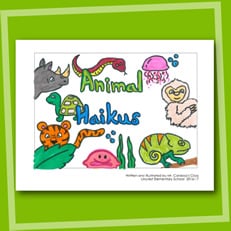 Poetry is a great way for students of all ages to learn how to express themselves and the world around them through writing. There are so many different forms of poetry to be explored, that it can seem a little overwhelming at times. By thinking about poetry in terms of a specific topic, like nature, you can help your young students find an easier approach to learning about and writing poetry. Below you’ll find poetry activities for 3rd graders created that all center around the outdoors and nature, giving your students something fun and tangible to inspire their writing
Poetry is a great way for students of all ages to learn how to express themselves and the world around them through writing. There are so many different forms of poetry to be explored, that it can seem a little overwhelming at times. By thinking about poetry in terms of a specific topic, like nature, you can help your young students find an easier approach to learning about and writing poetry. Below you’ll find poetry activities for 3rd graders created that all center around the outdoors and nature, giving your students something fun and tangible to inspire their writing
Poetry is not only important for self-expression, but it can help your students hone other writing skills like working with details, thinking about structure, and learning different ways to use language. These prompts also teach your students about different forms of poetry like acrostic, haiku, rhyming and free verse.
Poetry Activities for 3rd Graders that Incorporate the Outdoors
Writing poetry about the outdoors is a great way to get your students thinking creatively and get them excited about nature! When you work on these activities with your students, you are helping them dive deeper into the world of poetry and gain valuable writing skills that will help them throughout their academic career and beyond.
In addition to practicing writing, poetry prompts like these present the perfect opportunity to create a nature-themed classbook filled with poetry!
Writing Prompt #1: Write an acrostic poem about something you would find in nature
An acrostic poem is a poem that spells out an object, name, activity, or in this case something that your students find in nature. The letters in the chosen word are placed vertically on a sheet of paper, and each letter becomes the first letter of each sentence of the poem. The poems are meant to be about the word or object that is being spelled out.
With this prompt, it’s a good idea to have your students take a little trip outside. By changing up their environment, you can kick start their creativity and make it easier for them to visualize and write about the object of their choice. This poetry prompt will help your students think about descriptive language and details to include in their writing, while challenging their creativity within the structure of an acrostic poem. Some examples of objects in nature that they might find on their trip outside could be: cloud, tree, water, rock, etc.
See below for an example of an acrostic poem that might be helpful to show your students to help them understand the prompt.
An acrostic poem about SKY:
So blue when I look up
Kissing the clouds
You are always changing colors
PROJECT IDEA
After you take your trip outside, have your students write down words that they associate with their chosen part of nature. They can then figure out how to incorporate these words into their acrostic poem. Once your students have written their poems, have them illustrate their object visually - ask them to be as detailed as possible. Since poetry and the visual arts have so much in common, this project can help your students see the different ways that details and descriptive language can be expressed. By gathering all of your students’ illustrations and placing them next to their acrostic poems, you can easily create a classbook that showcases their work!
Are you Enjoying this Content?
Writing Prompt #2: Describe your favorite kind of weather using a Haiku
Haikus are a traditional Japanese form of poetry that puts a heavy emphasis on the structure and syllables of each word. Traditionally, haikus are written about nature and natural events that occur outdoors. This prompt brings out your students’ creativity by helping them see nature in a new way. Haikus also often focus on small details and descriptive language, which will help your students think about how to describe a concept like weather in the small space of a haiku.
The key to this prompt is making sure your students really grasp the idea of a haiku and what it means. The structure of a Haiku is three lines, the first line has 5 syllables, the second line has 7 syllables, and the third line has 5 syllables again. Here’s a great worksheet that will help your students when learning about the structure of Haikus.
Here’s an example of a haiku about the weather that you can use to help your students understand the structure of this form of poetry.
Strong wind is blowing
Papers swirling down the road
Hold onto your hat.
PROJECT IDEA
Have your students write down their favorite type of weather and all of the things they associate with it in a mind map. After they have their mind maps, have them choose a few words that they would like to incorporate into their haiku and use the worksheet above to write their haiku. Since haikus are all about using descriptive language and details, have them add an illustration. Have them draw out what their haiku would look like if it were a picture or a painting. This is a great way for your students to see the ways descriptive words and language are working in their writing and translate that into a visual form. Placing their illustrations next to their poetry is also a great opportunity to publish their work in a classbook!
Writing Prompt #3: What’s your favorite thing to do outdoors? Can you make it rhyme?
When students are asked to write about something that they love or connect with, their writing is often stronger and more exciting. Ask your students to think about what their favorite thing to do outdoors is. This could be anything from playing on the playground, participating a sport, riding their bike, walking their dog, jump roping, etc.
The purpose of this prompt is to have your students express their feelings about something they truly enjoy in a poetic way and show how poetry can communicate emotion. There are a few different approaches you can take with this activity, you can set a word or line length to have your students work towards, you can have them work with different rhyming patterns such as aba or abba, or simply rhyme in couplets.
This prompt is a more open way to think about poetry, as there are only two requirements: the poem has to be about something your students love to do outdoors, and the poem has to rhyme. By giving your students a poetry activity with a little less structure, they have a chance to dive in creatively and think outside of the box.
PROJECT IDEA
A great project idea for this prompt is to have your students share their favorite activity to do outdoors with the class and record what they say about the activity or write down their thoughts after they present. Your students can then take their recording or notes and use them to create a rhyming poem about their favorite activities After your students complete their rhyming poems, have them draw a picture of themselves doing their favorite activity and surround the image with words from their poem. Collect the poems and illustrations and combine them into a classbook. After you receive your books you can take your students outside and have them try out each of the favorite activities in the classbook to celebrate!
Writing Prompt #4: Exploring structure—Write a poem in the shape of something you would find in nature
Structure is an important part of understanding and writing poetry. This prompt helps your students think about how a poem’s structure can inform its meaning by having them write a poem in the shape of an object in nature that they find interesting. This is called a concrete or shape poem. This type of poetry has been used for thousands of years with one of the most
famous examples being “The Mouse’s Tale” from Lewis Carroll’s Alice’s Adventures in Wonderland. The shape of the poem is a pun on the word tale/tail, as the words go from a normal paragraph into a mouse tail shape.
PROJECT IDEA
Have your students go outside and find something that interests them that they can examine from all angles. Have them draw the object on a sheet of paper and take detailed notes about what they see. After your students have their notes, have them use those to write a free verse or rhyming poem about the object that they chose. They can edit and revise this draft until they are happy with the result. Once your students have the final draft of their poems, they can then write their poem around the shape of their object in nature and have it accompany the poem that they wrote in a classbook for everyone to see!
Poetry and nature often go hand-in-hand, and make a great combination when teaching your students valuable writing skills. These poetry prompts will help students think about things like descriptive writing, details, rhyming and structure. They also help your students get familiar with the different forms of poetry and language.
All of these skills will translate and follow your students as they get older and continue with their writing journey. Not only do these prompts engage your students’ creativity, they get them outdoors and allow them to take a closer look at what is around them!
Additional resources:
Looking for additional resources? Our online teacher’s lounge is an excellent place for you to find more helpful tips on improving your students’ writing. Head over to sign up and receive a free classbook publishing kit to make a special memory for your class.







